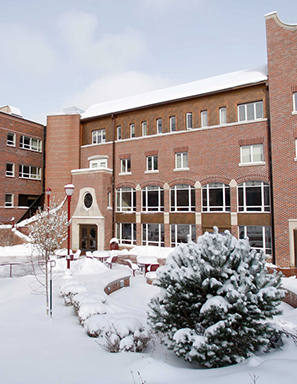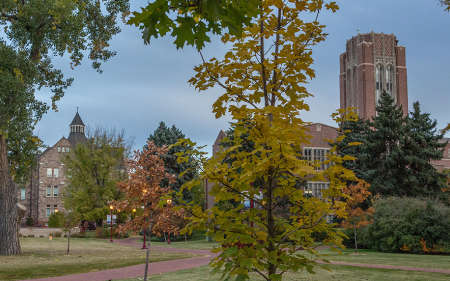Homelessness in Rural Colorado
GSSW’s Center on Housing and Homelessness Research is helping communities across Colorado to understand and address homelessness

Homelessness isn’t limited to Colorado’s major cities. Suburban and smaller rural communities statewide — many with relatively limited resources — are increasingly faced with challenges related to housing affordability, accessibility and instability, and how to best meet the needs of people experiencing homelessness.
Those communities are beginning to look to the Graduate School of Social Work’s Center on Housing and Homelessness Research (CHHR) for guidance in understanding and addressing these issues.
“We’re helping communities to see where they’re putting their time and energy, and we’re helping them get to a place of understanding how they can deal with homelessness more effectively,” says Gary Sanford, associate director of community assessment, technical assistance and training at the CHHR. “Good data are critical to understand who is in need, what exactly the need is, and how successful the interventions are. Without data, it’s like we’re throwing a lot of money into something but not getting much out of it. Without data, it’s difficult to assess outcomes and areas for improvement.”
CHHR is providing the data needed by municipalities such as Trinidad, Colorado, which hired the center to complete a community assessment. Located in southern Colorado, Trinidad is the seat of rural Las Animas County, which has a population of just over 14,000; 8,000 people live in Trinidad itself, and there is no shelter nor services to address homelessness in the area.
For three days in June 2018, Sanford and a team of MSW students — Kat Hughey, Abby Magnus, Amanda Seibel and Cullen Dilldine — traveled to Trinidad and conducted in-depth interviews with 63 of the more than 100 people sleeping outside there to understand their experiences with homelessness.
“The city knew there were a lot of people in the area who were sleeping outside, but they didn’t know who those people were,” Sanford says. “There are often misperceptions about who these people are.” For instance, Sanford notes, there was a perception that people experiencing homelessness were newcomers to the area.
Among the team’s findings were that nearly 40 percent of people experiencing homelessness in Trinidad had lived in the community for at least 6 years, and 31 percent had been there for more than a decade. Most were homeless because they couldn’t pay rent, had lost a job, or due to relationship problems. More than 20 percent of participants were dealing with serious health concerns — diabetes and asthma — and 16 percent had been hospitalized at least twice in the last year.
“Data begins to tell a more accurate story and paint a more understandable picture of the issues and need. We helped Trinidad see that they have folks impacting their systems — emergency response, health care, jail,” Sanford says. “Part of the effort is to help communities to look at what they’re already spending regarding the impact of homelessness.”
Data such as these will help the city to shape service responses and guide strategy to prevent and end homelessness, says Sanford, noting that the city is discussing creating supportive housing for individuals with a disabling condition that might inhibit their ability to maintain housing on their own.
Sanford joined CHHR in 2017, bringing nearly four decades of experience, including directing the Colorado Community and Interagency Council on Homelessness under former Gov. Bill Ritter and the Metro Denver Homeless Initiative. In 1986, he founded Urban Peak, an agency serving youth experiencing homelessness. More recently, as former Gov. John Hickenlooper’s advisor on homeless initiatives, Sanford developed Colorado’s first statewide plan to address homelessness.
After wrapping up the project in Trinidad, CHHR began working with Loveland, Colorado — the state’s 14th largest city. The center is helping Loveland to develop a strategic plan to address homelessness — from prevention to services for those experiencing homelessness.
“Colorado’s orientation to local control can cause some siloed efforts,” Sanford says. “In Loveland, the city can’t address homelessness alone; they have to work with Larimer and Weld counties.”
By working in a regional context, Sanford explains, not every community needs to offer every type of service, whether that’s supportive housing or a family program. Helping Colorado cities and towns to see possibilities like this and find ways to partner across jurisdictions is a key role for CHHR. “We help communities to recognize where they have strengths and how they can fill gaps. There is benefit for small communities to work together and share resources rather than working in siloes.”
CHHR is finishing a statewide inventory of homelessness-related resources in rural parts of the state, and assessment and strategic planning projects with other Colorado cities are on the drawing board. The center also is beginning to develop its training program to disseminate best practices to rural parts of the state, Sanford says.
CHHR projects have something in common: They’re community driven, and people experiencing homelessness are part of the process and the solutions. The project in Loveland, for instance, will include focus groups where people experiencing homelessness can share their first-hand experiences with systems.
“If you’re really trying to effectively engage,” Sanford says, “their voices have to be part of the mix to develop solutions and to adjust what we’re doing for better outcomes.
“These are our unhoused neighbors. These folks are part of our community.”




